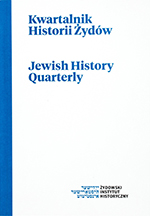Trzy sztetle bez Żydów
Three Shtetels with no Jews
Author(s): Andrzej Rosner, Łukasz KomorowskiSubject(s): Geography, Regional studies
Published by: Żydowski Instytut Historyczny
Keywords: small towns; shtetels; war damage; local economy; urban population; Gąbin; Przedbórz; Włodawa
Summary/Abstract: The article is about three small towns that had a large proportion of Jewish inhabitants before World War II and, consequently, a pattern of the local economy in which the businesses owned by the Jews played an important role. The three are Gąbin, a town and commune (gmina) seat located near Płock, Przedbórz, also a town and commune seat in Łódzkie voivodship near the boundary with Świętokrzyskie voivodship, and Włodawa, a county (powiat) seat on the bank of the Bug, near the point where the frontiers of Poland, Belarus and Ukraine meet. Despite the fact that since the end of WWII, Poland’s total urban population increased more than threefold, Gąbin and Przedbórz have not returned to their 1938 population level yet whereas Włodawa’s headcount increased in the post-war period, although this should be attributed to the town’s role as county seat, and since the 1990s that population has been shrinking anyway. In terms of economy, each of the three towns has a dearth of industry and a growing significance of their agricultural role. The three towns also share a relatively unfavorable pattern of education of its residents and a negative appeal to migrants, resulting in a deteriorating demographic structure.The inhabitants of these localities have not been showing a lot of interest in their Jewish heritage. Such interest has only been rising when there is an incentive from the outside, such as visits arranged by some landsmannschaft, a school project launched by some local activist, etc.
Journal: Kwartalnik Historii Żydów
- Issue Year: 280/2021
- Issue No: 04
- Page Range: 1087-1107
- Page Count: 31
- Language: Polish
- Content File-PDF

